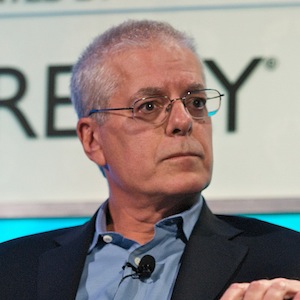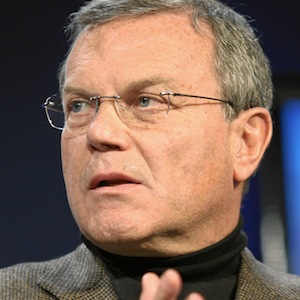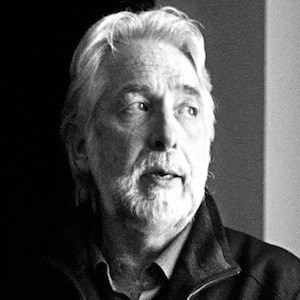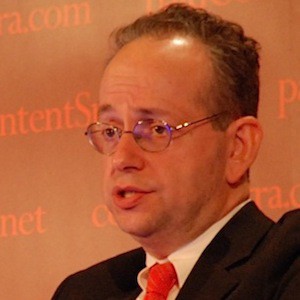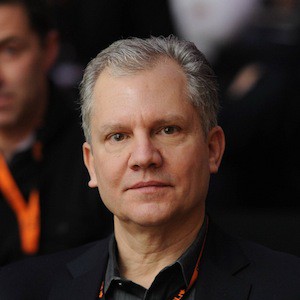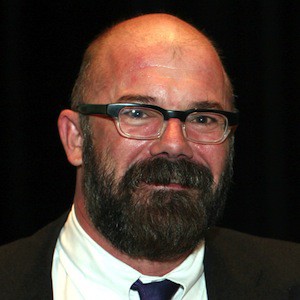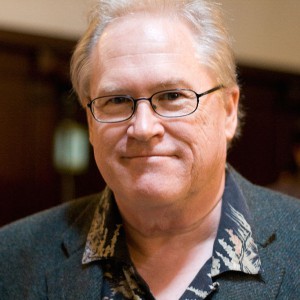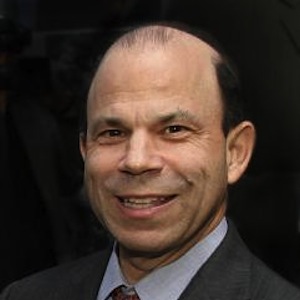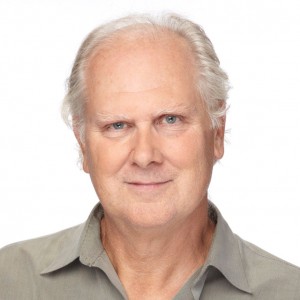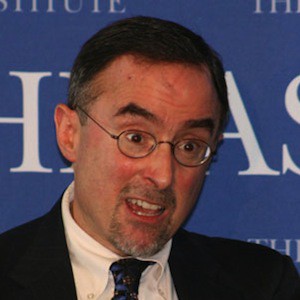John Huey: It’s April 16, 2013. We’re at the Shorenstein Center at Harvard’s Kennedy School and we’re interviewing Martin Nisenholtz, who is not only our colleague on this project but who built and ran the New York Times’ digital business for 17 years.
Paul: You should say you’re John Huey and I’m Paul Sagan.
John: Oh. I’m John Huey with Paul Sagan.
Martin, we’re going to ask you the same question we’ve asked everyone else. What was your first time?
Martin Nisenholtz: Well, that’s easy. I was a graduate student at the University of Pennsylvania. I was a PhD student and I was asked to take a year off on a research project.
John: What year is this?
Martin: 1979. At New York University. The National Science Foundation had funded a division of N.Y.U. to experiment with this new technology called teletext.
And, at the same time, they were starting a graduate program in what was called interactive telecommunications at the time. It’s now called I.T.P., which is one of the principal graduate programs in new media.
Red Burns hired me to participate in the teletext project. And I moved to New York, and I never moved back to Philadelphia to finish my doctorate.
John: OK. So you got involved with teletext in this project.
Martin: Yeah.
John: At that point, did you come into contact with the legacy media business? Someone hired you or you…
Martin: No, what happened is the teletext project was being conducted at Broadcast Station WETA in Washington. It was a Public Broadcast (PBS) station. There were several other teletext projects taking place at the time. About 1980, I would say, Time Inc. announced that it was going to do a large teletext project called Time Teletext. Jerry Levin was the sponsor of that project.
That caused a bunch of things to happen, including all of Time’s agencies, one of whom was Ogilvy & Mather, to begin to get interested in that technology, because Time wanted advertisers for its teletext service, and they went to the agency world to find them. So, in 1982, Ogilvy & Mather hired me as a consultant to begin to think about how to bring advertisers into the world of interactive media, and I joined the agency in March of ’83 and founded something called the Interactive Marketing Group, which was the first digital agency, you know, at a large advertising agency company.
John: Did it survive?
Martin: Yeah, it survived. Not only did it survive, but it became a successful business, and it ultimately merged with Ogilvy & Mather Direct into an entity I believe called OgilvyOne.
John: So you started the first digital agency. You’re a Ph.D. graduate student. You’re working for O&M. What are you seeing at this point? I mean, do you have a vision of what it’s going to become and have you thought at all at this time about journalism?
Martin: No. The journalism that was taking place were these short form screens of information that were being broadcast in these teletext and videotex projects, so it was a very limited form of interactive media, I mean in comparison with what exists today. I think, in general, the thinking was that, because the PC really hadn’t penetrated at all by ’81 or ’82, the only viable way to get interactive media into the home was by bridging the telephone network and the television set. Those were two ubiquitous technologies in the home, and so that’s what teletext and videotex services attempted to do in different ways, and they failed at the end of the day.
I can talk about why, but I think the more important point is that the PC, which was invented in the ’70s, I think in Xerox PARC… ultimately IBM came out with its PC in 1981, and that technology supplanted the videotex/teletext services so that, by ’85 or ’86, AOL had started. CompuServe, The Source and other online services were in the background operating as hobbyist services for the nascent PC users.
John: So, do you remember your first online experience?
Martin: Online, yeah. I mean, obviously, it would have been teletext.
John: Well, OK, I should have said online PC experience.
Martin: Oh, jeez, yeah, it probably would have been some form of accessing CompuServe is my guess. ASCII…
Paul: Which would have been…
Martin: Exactly. Text only. ASCII text, you know, screens of information.
John: But at this point you’re a pretty deep wonk in this world.
Martin: Well, there weren’t that many people working in this area mainly because nobody was crazy enough. [laughs] It was fairly early. There were a couple of other people. In fact, we interviewed Richard Gingras, who was working in teletext at the same time as I was doing that. So, there are still some people who are around who were working in the area. We talked to Tony Ridder who was the… obviously Jim Batten was the sponsor of Viewtron, but Tony was involved in that as well. Cathy Yates, others.
John: So, unlike everyone else that we’ve interviewed, you have the advantage of having talked to some 40 or more people who have been involved in this. You have a lot of firsthand, primary information of your experience, and you also know what everybody else remembers and what everybody else thinks, so why don’t you just start with The New York Times comes along. You end up at The New York Times, and give us about five minutes on what you think happened and why and how, and we’ll ask you questions as it goes, but just tell us your story.
Martin: OK. Well, as I just said, I came to The New York Times not as a journalist but as somebody who had been working in interactive media for… by that time it was 15 or 16 years.
John: What year did you go to the New…
Martin: 1995. So, by then, I’d been working in the field for many, many years, and my orienta…
Paul: I think it’s fair to say the PC had won. The Web was coming along, and the proprietary services you just referred to were already yielding.
Martin: Yeah, I’d say they were just beginning to yield. By 1995, I think AOL hadn’t even reached its apex yet.
Paul: Fair.
Martin: Yeah. I mean, AOL was really winning at that point. In fact, the Web looked so crude at that point to a lot of folks in comparison with the way AOL was working that some people felt that AOL would actually continue to grow for a very, very long time, certainly much longer than it did, as a proprietary service.
John: So The New York Times has the wisdom to hire you, and they bring you in, and the assignment is what?
Martin: The assignment is to get the Times on the Web. AOL had already convinced The New York Times to start an online service, and a group of folks had done that. It was called “@Times.” As I recall, it was a very limited, mostly an entertainment service. There was a feeling, I think, at the time that certain people at the Times didn’t want online services to compete with a businesses that had been set up in the B to B space. I mean, it’s a more complex story.
In any event, I arrived at The Times not from a journalism organization, but with an interactive media background. My orientation in coming in was really more AOL, Yahoo, other native Internet companies. Other native interactive companies, I should say, because AOL” wasn’t strictly an Internet company at that time.
My thinking was, The New York Times should maybe approach the web, in some ways, the way Yahoo did. Yahoo was a directory. I thought, “Well, jeez, The Times could do, in essence, what “Yahoo” was doing. It could find the best stuff for people.” The journalism of The Times, probably, was not at that point in any event, very interesting on a PC. It was very, very clunky. But I realized very quickly that was not going to happen.
What The Times wanted, for good reason in some ways, was to publish the journalism of The New York Times on the web. In fact, that’s what I think, probably, 99 percent of the people who would use The New York Times on the web would expect from it.
Now, of all the things, of all the decisions that have been made, I think that one is the most seminal. The idea to publish what was, in essence, the newspaper instead of going in a different direction at the outset.
I think that, certainly, publishing the newspaper on the web is what was expected. It’s what the consumer expected. It’s what was logical. It was low risk, in many respects. It didn’t cost very much because we already had the content. It made a world of sense.
But, in some ways, some fundamental ways, it kept The Times from truly being a great innovator because it didn’t allow for something startlingly new. [laughs]
John Huey: So that was the big fork in the road?
Martin: That was the big fork in the road. Not whether, in my view, you charged for content. The big fork in the road was publishing the content of The Times versus doing something else.
John: So, you hadn’t been in the news business and you’re there. You’re looking at it. You look around at the competitive landscape. You’ve mentioned quite a few things there that you saw. So could you talk a minute about that, about Yahoo and CNN.com?
Martin: Sure. What occurred to me almost immediately, is that the distribution silos that existed in the past were going to go away very quickly.
Paul Sagan: You mean by those, media distribution not online competitors, but traditional…
[crosstalk]
Martin: Right. We would not be competing with other newspapers. We would be competing with a whole range of providers. And CNN had already come on and was doing a very good job. It had breaking news in its DNA. It was writing short form, very pithy, good articles for the web.
Remember, it was a desktop world, small screens, not very much resolution, slow modems, narrow band connectivity. And so, you know, you’re talking about a user experience that is, in comparison with today’s user experience, pretty clunky. CNN had done a pretty good job, mapping the content to that user experience. They, in my view, set the bar on the news side.
Now, there were a lot of people who felt that the content was not as deep, or as analytical, or as interesting, as New York Times content. I would agree. It was very difficult to read long form New York Times articles on a screen at that time. It’s become much more comfortable to do with an iPad or even a modern display device, but at the time, it was really clunky.
So, we were competing, yes, with CNN roughly at the same time as we came on, maybe a little later. MSNBC came online. Yahoo News was already online, I believe, with the full Reuters feed so that was very current, also very comprehensive.
There were a couple of other newspapers that had come online and were producing pretty good reports. The News and Observer had a news website called NandO. I believe The San Jose Mercury News was up with Mercury Center.
Yes, there were quite a few online newspapers and they were all free. I shouldn’t say newspapers. There were quite a few online news services, including the cable folks. I don’t remember whether ABCNews.com came up in that first year or not. My sense is it probably did not.
To your question, we were colliding, now, with a range of media competitors, not just newspapers anymore.
Paul: The magazine companies had started updating more frequently than weekly or monthly, as well?
Martin: Yes. Certainly, Pathfinder had come online. They were one of the earlier services which, of course, you ran. There were other services, as well, all of which were coming together in this space. All of whom were, now, going out and trying to attract advertisers.
John: We don’t want to dwell on this too long because there are exciting things to talk about that come later, but looking back on it all…One of the things we’ve talked a lot about with other people is the cultural issues and the cultural barriers of both legacy news business and of successful businesses trying to innovate. Do you have any rich memories of that period?
Martin: The fact is at the outset, certainly, for the first two or three years…I want to be clear I don’t say this for any other reason that it’s true, I was incredibly well supported at The New York Times. Joe Lelyveld, who was the executive editor at the time, and Russ Lewis, The Times’ general manager, couldn’t have been more supportive.
The fact is, hindsight is 20/20. It was a small effort, a small experiment, with a very small impact. For most people in the organization, it really didn’t touch them very much. It’s not that people were hostile or that they didn’t want to do it. They just didn’t care very much to be perfectly honest.
Paul: It was just peripheral?
Martin: It was totally peripheral, totally marginal at the time. Now, that’s changed, obviously, but at the time it was marginal.
Having said that, I think there was a clear expectation that The Times on the web would be principally re purposing The Times’ journalism.
I will go back to this theme. I think, if I could do it over again, one of things I probably would have pressed harder, although the financial side of this would have certainly intruded, was to do something more aggressive, maybe with the Times brand as a side project, or with an entirely different brand. But certainly the Times I think could have played a broader role than simply one that reflected its newspaper.
Paul Sagan: Just to pick on some on some of the themes we’ve asked other people about, it was not an engineering led effort?
Martin: No.
Paul: Or it wasn’t an editorial led effort? Because you’re certainly in charge, and not a very large engineering staff. You talk about roads not taken. It wasn’t as if it was an engineering company that you had that you restrained from becoming…
Martin: No. I understood the technology extremely well at the time, and while I’m not a trained computer scientist I had been around it and created a lot of stuff in the online arena for 15 or 16 years. I was very well versed in the technology. As I say, I came to the position with the idea that we could do something fundamentally different than we ended up doing.
But yes, to answer your question, I’d say that in a major news organization, the culture is such that journalism typically is in the lead position. That’s the business the company is in.
John Huey: What is the next aha moment? You have this peripheral effort going on.
Martin: The next aha moment came with the dot com boom. The dot com boom starts, and all of a sudden we’re seeing people leave the organization. We can’t hire people because people are expecting stock options. By 1998, I would say it was clear that something much more, let’s just say interesting, was going on, than a small bore experiment.
At that point, Russ decided we needed to breakout into a totally separate operation. I believe he had read the “Innovator’s Dilemma” by Christensen, and sort of believed that in order for us to truly get some kind of scale here we needed to have our own separate operation.
John: Tell us about that. That happens.
Martin: Yeah, so that happens. There was let’s just say a very vigorous debate in the company as to whether we should be broken out or not. Obviously the folks at the newspaper were not happy about losing control of their website, which in many ways I don’t blame them. But it was determined that we would become a separate digital operation, much like many of the other operations that existed at the time.
In addition we would pursue a public offering of the stock, which again, other operations were doing at the time. Some news operations, some not. Barnes and Noble, for example, had a separate company with its own stock. That was the seminal moment. I would say the other thing that happened at that point is that we decided that we really did, to Paul’s earlier question, need to ramp on the engineering side, and we acquired a company called Abuzz, which had been started at MIT. It was a precursor to businesses like Yahoo Answers and Quora.
It was a very sophisticated question and answer platform. At the time, it was called a knowledge management platform where people would put questions into the system and the system would find in this vast network of users the five or six best people to answer those questions, send them the questions, and then the answers would come via email. We acquired that business, acquired the engineering team, and began to integrate that capability into the Times on the Web. That was our attempt to create some platform economics around the Times on the Web. That was in ’99.
John: Tell us how the public offering comes to an end?
Martin: It came to an end in a very strange way. We were working with Goldman Sachs.
John: What year? What month?
Martin: We worked through much to the latter half of 1999, and now into 2000, AOL had just acquired Time Warner. We were sitting in a room with our bankers, the Goldman folks. I believe it was April of 2000. Taking a company public, you work very closely with your bankers. You’ve created this thing. It was actually a tracking stock. We created this document called an S3 which is like an S1 except for a tracker.
We were rehearsing the road show at that point. At that time I think people were still carrying beepers. Remember those little beepers? They started to go off all in unison. The Goldman folks basically said there’s some issue…I think the market was actually diving hundreds of points that day. They went back to Goldman, but they said, “We’ll be back tomorrow to rehearse again.” We never saw them again. [laughs] Because the dot com boom was over, so there was no IPO. [laughs]
John: For you the dot com boom had a very personal pointed and dateable moment.
Martin: Well it came to a very sudden end. There was a sense that we might reinvigorate the IPO, but as 2000 wore on it became clearer and clearer that this fantasy was just that, and there was no dotcom boom anymore. [laughs]
John: Takes us through the 21st century up to now…
Martin: Yes. [laughs]
John: …before we circle back and talk about in general.
Martin: Then the dot com bust happened, the Web winter.
John: Web winter?
Martin: Yeah, the Web winter. Like many big media companies, the Times needed to retrench some. I was told, “Look, you got to find a way to get this thing profitable. We’ve invested a lot of money in it.” 2001 dawns, and in January we had our first series of layoffs, and then in April it became clear that the recession was going to be even deeper. We had a second series of layoffs. We did manage to at least get the business to cash flow profitability by the end of 2001.
Paul: How big a business is it? How many people are in it?
Martin: That’s a good question. I think probably, I’m going to guess, at that point across the company, maybe 140 people. But we probably lost 40 percent of them in 2001. It was really taken down. I’d say that the revenues at that point were maybe 25 or 30 million dollars. Remember we also had this B to B entity embedded in the overall business that included our LexisNexis deals and others. I almost don’t count that money because it wasn’t dotcom money.
Paul: The consumer business, the dotcom business, was very small.
Martin: Well yes. Once the dotcom bust happened, it got very small, very fast. That’s why we had to retrench. Because there wasn’t any sense of when this might come back. Now I do want to say that from a usage perspective, the dotcom bust didn’t do a thing to our usage curve. Our usage curve was a straight line growth.
John: This was all about advertising. Right?
Martin: This was all about advertising. Yeah, it was all about the stock market too. If you plot the NASDAQ it looks kind of like a wave form. If you plot our growth rate, it looks like a line, a straight line up. The consumer basically all through the dot com bust, was saying, “I really like this.”
John: But the economic model had eroded.
Martin: The economic model had collapsed. It hadn’t eroded. It just collapsed. It was very, very difficult to sell Internet advertising. In fact, we started the OPA in 2002, because the buzz on the Online Publishers Association, because the buzz on Internet advertising was so bad, that I felt that the industry needed to come together and put a fact base out there that at least said, “Look, there are these users who are actually using these services, and they actually see these ads, and they respond to them in these ways.” We did put that fact base out there. Michael Zimbalist came in to run it.
Paul: That’s right. Web 1.0 happened with too much hype much too publicly. In many ways Web 2.0 happened much more out of view, but much more as a reality.
Martin: Yeah. Well Web 2.0 was really defined by Tim O’Reilly and I think to some extent John Battelle a little later on, I think around 2004. But the beginnings of it had…
Paul: But it’s happening.
Martin: It’s happening right as the…yeah.
John: Does that mean network ad sales and all that?
Martin: No, no. The idea of…
John: Let’s go to Web 1.0, Web winter, and then Web 2.0. But before we get to Web 2.0, would you just answer this question, which is, “What were you and other digital people thinking, and what was ownership and the leadership of the company thinking Web winter meant?”
Martin: Well I can tell you what it meant to me, it meant some of the best Internet businesses on the planet were selling at unbelievable discounts. That’s what it meant to me. I think what it may have meant to some of the more traditional folks is that this was a bunch of bull and it was over.
John: Do you agree with the people who say because of that, that gave the advocates for the traditional print arc of journalism to say, “OK, well this turned out to be a bust. We need to get back to our knitting and reinvest and push that over digital? Or is that exaggerated?
Martin: I think that maybe a little exaggerated. First of all, I wouldn’t say, certainly speaking for the Times, from a perspective of having been at the Times, we ever stopped focusing on our knitting which was the journalism and whether it was in print or digital.
John: Well I’m talking more about economic financial, where you’re investing your money in digital and digital growth.
Martin: Well no. Certainly, once the dot com bust happened, I think there was an expectation by the Street, if no one else. Look, you got to put yourself in the position of being a public company CEO at that time. There were very, very few public companies CEOs that I know of that did any investing during the dot com bust. Whether they were newspaper CEOs, broadcast CEOs, they basically all ran for the hills.
John: But you’re saying that you, in your view, there were a lot of values out there.
Martin: Yes. Absolutely were. Barry Diller, who is a very smart guy, was investing heavily in some of those businesses at that time. It wasn’t like no one was doing it. He was the one guy who was doing it at the time that I can recall.
John: Take us into Web 2.0.
Martin: Right. As Paul just indicated, Google was founded I want to say 1998 or 1999.
Paul: ’98.
Martin: Right. By Larry Page and Sergey Brin. What was very interesting about Google, unlike the Web 1.0 companies, which really were portals for the most part. They were destinations that you typed a URL into and the whole purpose of them was to keep you in the environment. Web 2.0 was characterized by joining many web companies in a loose federation.
And so, Google’s entire raison d’etre was to get you off of it as quickly as possible. It was to get you in and off quickly. That was not something that a lot of Web 1.0 folks thought would be a profitable model. But, as it turned out, it was the most profitable model anybody could possibly dream up because the notion of intent was clearly…
Now, I don’t…Just to be clear, just for the sake of the folks who may be listening, there’s a very clear definition of Web 2.0 that O’Reilly and Battelle wrote that is on the O’Reilly website that everybody can read. I don’t remember all the attributes of it, but it’s there to be read if anyone wants to read it. We should link to it.
http://oreilly.com/web2/archive/what-is-web-20.html
Paul Sagan: And I meant it more as shorthand of the second phase of development of business models and where the audience went and which companies reigned supreme in the next phase.
John Huey: Just to get very parochial here, I would like to point out one huge difference between Web 1.0 and Web 2.0 was in Web 1.0 the big players spent heavily on print advertising.
I was the editor of Fortune Magazine in 2000 and we had several 500 page issues. And we earned over 100 million dollars in operating profits, driven principally by this wind at our backs from web 1.0.
And the Industry Standard in that year sold more advertising pages than any other magazine in the country. The next year, it went out of business.
Martin Nisenholtz: Well, that was Battelle’s magazine.
John: Right. And it had a very small circulation. And it sold more ads…
Martin: Yeah, I remember that issue.
John: Because I was in negotiations to buy it at one point. But the next year, it was gone, and then as web 2.0…you get through the web winter, web 2.0 comes along, and the Googles and every other player, there’s no or very little print advertising. It was self contained on the web. So print got left behind in sharing in the bounty of that.
Martin: Right. Well, the classified business never really recovered from the recession. Monster, by then, had become a very dominant job board. And of course, Craigslist was spreading all around the world by then. So you’re right, the classified industry did not have a typical cyclical rebound following the 2001 recession.
John: So now, here you are. You are leading the digital effort of the most successful newspaper in the country, the most serious about its news report. And you’ve made it through this web 1.0 in a very disappointing fashion. Web 2.0 is starting to come back. What are you thinking then, and what do you do? There are acquisitions, there are…what’s your…
Martin: Well, no, I mean, I think at the time, as I said, my perception was that there were quite a few great Internet companies that could have gone for fire sale prices. But as I said, we emerged out of web…we emerged out of the web winter. The advertising markets began to come back around 2003. And we really began to grow robustly once those markets returned.
John: “We” being?
Martin: The Times on the Web, and Boston.com, which was obviously still in the portfolio. But the Times on the Web, by then, was the largest newspaper owned website in the world, which was not necessarily an intuitive position for us to have, given that the Times in print had always been more of a niche. We did manage to get into that position and to hold that position, which I was always very gratified by — as largest the largest newspaper owned website in the world with this unbelievable audience I mean, we had a great audience — this was before you had Facebook out there with a billion users. Yahoo was out there with maybe 120 million uniques.
John Huey: But this is back when 20 million uniques meant something.
Martin: This was back when 20 million uniques meant something, exactly. And so our feeling at the time, and boy, was I wrong about this…there were a few things I got very, very wrong, and one of them was scale. I thought if we could get to 70 million uniques, 50 to 70 million uniques, globally, we were just going to be a major, major player globally, because of the character of our audience, and that size, we might not be the size of Yahoo, but it didn’t matter. And I was off by…100 million uniques today at Facebook is a rounding error.
Paul Sagan: You’re an order of magnitude away from being…
Martin: Yeah, I’m off by two orders of…yeah, I’m off by…no, by a lot. Put it that way. I was very, very wrong about what would happen, the definition of scale on the web. I just got that fundamentally wrong. I think the other thing I got wrong was that I really did expect that traditional media — not just newspapers and magazines, but television broadcasting as well — would start to give up brand advertising much sooner than it has. I think it eventually will, but it hasn’t yet, not in any numbers that you would be really staggered by. The business has really gone into a kind of direct response mode.
John: Explain that a little. Give us an example of that.
Martin: Well, the examples are everywhere. The advertising metric that was most used from the beginning was the click through. My hope when we started the OPA was that we would migrate well beyond the click through to a more traditional set of brand metrics, and those brand metrics would be tied…you could have offline to online measures and attribution.
John: So you’re selling influence and engagement and impact and all that kind of thing.
Martin: Yeah, you’re selling more than just a click, put it that way.
John: Right, but at the same time all the digital businesses at that moment are still chasing traffic, because you’re thinking scale is 70…
Martin: No, I guess what I’m saying is that if anything, the creation of Google really doubled down on the click. People get paid on clicks with AdWords and then AdSense. The click became the currency online. From there, the direct response economics — retargeting — the idea that data was at the center of the web’s value proposition for advertisers arose in a way that went well beyond any single publication and is now today a part of this overall trend toward programmatic.
John: Which leaves newspapers like The New York Times where?
Martin: Well, it leaves all premium brands in the position of having to create very, very special advertising experiences, campaigns, for their clients, which are sometimes called native campaigns or native advertising positions that break through what you can buy, in a sense, off of the exchanges, the traditional banner ads, by the pound.
John: Are you optimistic about that business?
Martin: I’m optimistic about the fact that I think…let me put it this way. I think that there will always be a role for premium, well constructed, well designed advertising on the web. What I’m a little bit disappointed, or maybe more than a little bit disappointed about is the creativity that the industry has brought to that.
The Mac/PC campaign which appeared on the Times’ home page a few years ago, I think, is still the best example of a cross media campaign executed on the web in a premium environment. It was us. It was the Journal. I think maybe one or two others. It was just witty. It was interesting. It was just a great campaign.
Unfortunately, there aren’t that many people creating that kind of advertising. And so, what you have is a lowest common denominator approach oftentimes.
I’m certain, having seen that Apple campaign, it can be done. It’s a shame that it isn’t done more often. That’s…
John Huey: The world would be very different if there were a lot of Apple computers and Steve Jobs who cared about creativity and where they advertise.
Martin: It certainly would be.
John: Because he also advertised in outdoor, magazine covers, New York Times. He liked those.
Martin: Lee Clow should be given some credit, as well.
John: That’s true.
Paul Sagan: I was going to suggest we should take a break and come back.
Martin: That’s fine.
John: Can we ask one question before we do that because we’re asking all these big questions and we’re just right in the middle of this.
Could anything have been any different? Just that one big question.
Martin: You mean in an overall industry sense?
John: Is there anything you could have done or the industry have done or the New York Times have done that would have made any big difference? And then we’ll take a break.
Martin: I think that there are two answers to that question. I think from a company perspective, yes, I think that companies could have been much more aggressive and much more imaginative in developing businesses that may not have had anything to do with journalism, per se, but which are very big and profitable businesses, OK? And whether you view that…
John: Like say Bloomberg instead of…Dow Jones instead of Bloomberg?
Martin: Whether it’s Dow Jones instead of Bloomberg or whether it’s company X owning…I’m just sort of pulling this out of the air, but a business like Expedia, which of course, Microsoft sold to Diller, whether it’s either one of those or any number of examples, you could certainly envision that to have taken place.
If you’re asking about whether I think journalism itself could have taken a fundamentally different course, I’m not sure there’s a good answer to that because fundamentally what happened is that the old packages became unbundled. And that was an inexorable development.
Paul Sagan: Martin, we’re back again. You described that the ad world or the model collapsed all around the industry. Let’s go back to another fateful decision. Some have called it the original sin of the media companies, which was not starting with paywalls, not being patient, and giving content away for free, which earlier you described as not, you think, one of the major decisions.
But a lot of people have looked at that and said that was a pretty major decision and many, particularly the Times, was one of the leaders in deciding not to do pay.
Can you take us back to those times and what you were thinking and why that was the obvious decision then?
Martin Nisenholtz: I want to reiterate something I said before, which is that there was a collision of a whole bunch of different industries at once. CNN had already come out with a very good free website. There was no indication that they would ever change that model. They had a cable model and they were, in essence, going to be advertiser supported.
Paul: And in fact, our interviews with Harry Motro and Scott Woelfel confirmed that. Their model was that they were going to be free.
Martin: Absolutely. The Yahoo News folks had launched with Reuters. They actually had the portal to depend upon. As did MSNBC.
Paul: What year was this decision?
Martin: I want to say the decision was made in late 1995. We knew that in order to build an advertising business we needed to build an audience. We were thinking very flexibly about how we would ultimately charge, if we would ultimately charge.
We decided to run an experiment outside the United States where we did charge, which is something a lot of people forget. The website was free in the US, but outside the US you had to pay for it. We kept that going for about 18 months.
We got, I want to say, about 3,600 subscribers. One of the things I like to say is we ended the experiment on Bastille Day, and that day, I believe it was in 1998, we got more registered users in about an hour than we had subscribers in the last 18 months.
The fact is that, at that time, in a general news context, given the quality of the product that we were building in a narrowband context, very crude technology, we absolutely, I think, made the right decision to build the audience because, as I think we’ll get to later, we’ll see that a lot of the economics of going pay have to do with conversion rates off of your loyal base, the people who are coming to you every day.
So those conversion rates are very material. The bigger your audience, obviously, the more people will convert. I think, a little bit later, we’ll probably get to a point where you’ll see the logic of having a big audience, not just in the advertising context but in the pay context, as well.
Paul: I think it’s worth just reminding people, because it does seem just a little bit like ancient history, today’s model, and you’ll get to it in a minute, of the meter. X number of pages for free and then the wall goes up and you have to pay, but you can link in and out. That technology was not available then.
Martin: That idea was not…
Paul: You couldn’t have done it.
Martin: I don’t know if we could have done it or not, Paul, but the fact is, maybe it was a lack of imagination, but at least at the time the thinking was very binary. Either you were going to be free or you were going to be pay.
Paul: Just to remind people, even back ’95, ’96, ’97, the act of taking a credit card online or having a multiple payment system was not all that easy. Even a commerce server was not easy to set up, relatively. Not to make excuses for the past, but we made some of the same decisions at Time, Inc. and Time Warner at the same time. It was pretty crude tools.
Martin: In any event, honestly, I don’t remember that being the barrier. I’m just suggesting that, at the time, there was no hint of a metered model. Our decision to build the free site had to do with building a large global audience. We felt the Times had finally become completely unshackled from the distribution constraints. Unlike any other newspaper, certainly general interest newspaper in the United States, we had the capability of really building a big, global audience for this brand. And that was something that I think within four or five years, we proved we could do by ultimately becoming the largest newspaper owned website in the world, so…
John: Put that in a context of when we talked to Gordon Crovitz, he said that the two of you exchanged views often. And they were a national newspaper, had been a national newspaper for a long time, with a worldwide global information system. And they decided to stay behind the wall. Why was that the right decision for them?
Paul: And “they” meaning the Wall Street Journal.
John: “They” meaning the Wall Street Journal.
Martin: I always thought it was a decision that was made based on two notions. One was fear. I think they were afraid that if they went free, their paper would simply be cannibalized because let’s keep in mind that this was well before Rupert bought the business, and they were a core business to business product. They were not a general interest newspaper.
John: No, but they had a circulation of almost two million at that time, which was bigger than the New York Times.
Martin: No, I’m not arguing with that. I’m just suggesting that they had a different positioning in the marketplace than we did. They were a business to business product, and we were a general interest product. Even though we had a business section, have a business section, their whole focus was business at that time. I think they were deeply concerned about cannibalization. And by the way, there were folks at the Times and other general interest newspapers who were very concerned about circulation. As it turned out, the web became a very significant source of print starts. Within four or five years, it was driving more print starts than…
John: Print start being New York Times-ism for subscriptions?
Martin: Yes, print subscriptions to the paper, print subscriptions, yeah. But in the earliest days, there was a fear, I think, in a lot of circles. But in particular, in a business to business product like the journal, that there would be some cannibalization. I think the other, and Gordon expressed this, I thought, well, is that they just felt that their information was such they could get a price for it. So they doggedly developed a subscriber base from zero people over a very long period of time.
My view is that two things happened as a result of that. One is that they never really developed a large audience, not a really large audience, on which to build the advertising business. They were constantly running out of inventory. The second…
John: Which led to their buying Market Watch.
Martin: Not only did it lead to their buying Market Watch, I don’t think, and I think Larry confirmed this in his interview, that Market Watch would have existed if the Wall Street Journal had been a free product. I think it would have basically…there would have been nowhere for them to go. I think that the fact that the Journal was a paid product from the beginning allowed Larry to come in and build that. He’ll argue that some…that they’re a little bit different. Obviously, the Journal was more focused on covering the world of business, and Market Watch may have been a little bit more focused on individual investors.
Putting that aside, ultimately the Wall Street Journal had to pay over 500 million dollars to buy Market Watch. And that’s a high price for a company of that size. From a strategic perspective, I could argue that they made the right decision, didn’t make the right decision. I think certainly for the New York Times, we made the right decision.
There were many decisions that we made that were not right, but this is just not one that I believe is worth relitigating.
Paul: Then let’s fast forward over a decade. And in the last couple of years, that model flipped or started to flip to this idea of the meter. So describe where that concept came from, which was the metered model, as opposed to the paywall, because they are different, and they often get lumped together.
Martin: Oh, but they are very different.
Paul: Describe that and then describe what’s happened so far and what promise that brings to this question of journalism in the digital age.
Martin: Just before we get to the metered model, I do think it’s important for people to understand that we continued to experiment with certain kinds of paid services from the beginning. TimesSelect, we implemented, which was a hard paywall against just our Opinion content…
Paul: Thanks for reminding me. I was going to ask you…
Martin: …which quickly developed into a $10 million business that we judged to be problematic in a couple of other ways, but at the end of the day, I would hardly suggest that it was a failure. It was larger than many websites even today, in terms of revenue production, just that. That was one experiment we did.
Paul: That was effectively putting the columnists behind a paywall.
Martin: The columnists and the (news) archive. I think it was the entire…Yeah, it’s effectively the columnists, yeah. That was essentially what people thought of it as.
John: For one thing, it made people in India have to pay if they wanted to read Tom Friedman.
Martin: Which I think is a problem because obviously that content…The problem I always had with it, as an idea, is that…I know it’s a cliché, but I do believe that the web is a big global swirling conversation. If you take yourself out of that conversation as a news company, you diminish significantly many things, including your brand, your reach in the marketplace, and your influence. That’s a problem. I think intuitively, the columnists knew that. That’s why perhaps some of them may not have been such big fans of it.
It ended. One thing about the Times is, we may make mistakes, but we ultimately, I think, get there. The fact is, it ended. It ended right as the era of search was booming.
We had acquired About.com and really got very, very capable in terms of SEO (search engine optimization) and insinuating our content into Google so that we added tens of millions of new users as a result of that over that period of time.
That was the TimesSelect thing. We had other experiments going. We were charging for our crosswords, for example, so we created a little games business, which is a few million dollars now. It’s not like we weren’t thinking, “Well, can we monetize this content in other ways other than advertising?” We were always doing that.
I think to get to the metered model, I think the breakthrough there happened when we saw what the FT was doing. The FT was the pioneer in that model. They had succeeded with it and they were very, very open, generously open, in terms of sharing information with us.
I think we saw this as a great solution because it both preserved the very large audience that we had of fairly light users. Most news companies, all of them in fact, have a very significant audience of light users who come in from search and blogs and email and all these side doors, Facebook, Twitter. And a relatively smaller group of deeply loyal either everyday or every other day people coming in and actually using the product directly.
The recognition of that created this notion of a metered model or a “freemium approach,” some people call it. We got that idea pretty much from the FT and then refined it after that.
Paul: Describe how it’s implemented and what it’s done.
Martin: It’s very simple. The idea is that users get up to a certain number of pages per month for free. I think we started at 20. I think the meter is now at 10. That allows you to provide this massive sampling of content to tens of millions of people each month. It also provides inventory and reach for your advertising business. From the side doors, by that I mean companies like Facebook, Twitter, Google, etc., you can go to a search and get again, an article for free or if somebody wants to share an article, they don’t have to send you an article that you’re going to hit a wall on. It’s a very easy and friendly way of dealing with content on a global web.
Paul: If you hit that number, what happens?
Martin: Once you hit that number…Before you hit that number, you’re told by the system that you’re about to hit the number and hopefully you’ll subscribe at that point. Once you hit the number, then you’re unable to see more content until the first of the next month. You’ve used your quota. Then you come back and on the first of the month, get a new meter. In essence, the meter is reset.
Paul: At least in 2013, what’s the result? Some of that’s been publicly reported.
Martin: A lot of it’s been publicly reported. The result has been, I think, stellar. It’s certainly exceeded, I think, the Times’ expectations of what would happen along essentially three dimensions. Dimension one is the number of subscribers. I think we talked about 640,000 in the fourth quarter of 2012. We’ll release earnings, I think, this week or next, we’ll have a first quarter number very soon. I think by anybody’s calculus, the number of subscribers is positive.
Secondly, we thought that it would diminish the advertising inventory more than it has, so more free users are coming than we expected.
Third, there was some thought that there would be a migration out of print and into the web faster because of the price differential, and that hasn’t happened. It’s actually been additive in some ways to the print side.
I think the model has been a success pretty much along mostly every dimension that you can think of. That’s why, I think, you’ve seen so many other newspapers take a whack at implementing this model. I think at last count, there was something like 400 or 450 newspapers in the US pursuing a metered model.
Paul: Let’s take a really broad arc to this. Because as you described at the beginning, you were involved in the earliest projects. As we’ve looked at this as a 40 year span of when digital technology first started to show up to today when it hits full blown, lots of video and broadband always on and moving to ubiquitous and mobile. What are the two or three lessons that you’ve drawn from this? Particularly for where media companies went right or wrong or the lessons they learned, good or bad through this experience. Because most of them waded right in got knee deep or deeper, and not all of them have come back out.
Martin: The whole notion of the swimmers and the tide, which is something that we’ve been talking about from the beginning of this project. John coined the metaphor, is I think a very material part of your question. How much could anyone have done given the very profound changes that are taking place in the technology and whatnot. I think you have to parse that carefully because on the one hand, you can say, “OK, if we had done this, this, this, and this we might have preserved certain economics in a different business.” An example might be today you see a lot of newspapers locally going into marketing services, which is a whole new area of revenue production for them. They may succeed at that. They may not, but it’s a different business.
Versus keeping the Baghdad bureau alive or covering the local city hall. The linkages between those two things, I think, are very, very important, Paul. Understanding that yeah, a company can perhaps succeed as a business without succeeding with its civic mission.
That’s one thing I would draw as a conclusion, that the separation between the business side and the mission side is important to make.
The second thing is I really believe, and I think this is reflected in many of the interviews, that there will be and have been a lot of incredibly positive movements in journalism from this statement.
I don’t believe that a world of 1979, when I got into the business, where there were three broadcast networks and a handful of magazines and a newspaper in each town, and nobody got to have any participation very much in any of that, is not particularly healthy.
I think, for all of the problems that journalism has, the world that we live in today, the world that we inhabit today, is exponentially richer and more interesting. Will that continue over the next 5 to 10 years? I have no idea, but I know that today, on any given day, my Twitter feed is full of more interesting things than it was probably in a month 10 or 15 years ago.
For whatever it’s worth, I have a very positive view of the impact of digital technology on journalism. That’s the second thing I would say. We can continue this conversation, but I don’t know that there’s much more to say beyond that. You need to ask me more specific…it’s a little hard to…
John: If you go back and go through each major…
Paul: You thought you were done at the dentist’s office.
Martin: It’s a lot easier being on the other side of the camera. No, I’m kidding.
John: Just go quickly through each of the eras and how you think that era led into the next era, starting with teletext and its effect on what the industry did, going to proprietary walled garden, Internet, search. Just, very quickly, bullet points.
Martin: The industry invested heavily in teletext and videotex in the early ’80s. The media industry failed to gain traction with those services. They shut them down. To go back to Paul’s question, one lesson learned there might be, instead of going in with 300 people and trying to conquer the world inside of 18 months, maybe a more entrepreneurial approach would have been better. In other words, slower in, more patient, more committed, over a longer period of time, in order to find out and then discover and iterate on what the consumer actually wanted. Lesson learned there for me was entrepreneurs trump big iron in almost every instance. Absolutely true. I don’t think there’s a single case that you can make where that isn’t true, particularly of that era.
John: While they were doing that, and they were doing it with the television and telephone, the PC was growing.
Martin: Nobody could have seen that, so that would have been part of the entrepreneurial approach.
John: Right.
Martin: And it was.
John: Somebody would have said, “Hey, let’s try this…
Martin: Let’s move over to the PC, right. So that’s in essence what happened. Quantum actually started as a PC based service which became AOL. The second big thing that happened out of videotex and teletext is that it created a sense that the Internet or interactive…not so much the Internet, but interactive media was a failure, that it wasn’t something that the newspaper or journalism industries needed to be concerned about.
That created a huge eight year gap, pretty much from roughly 1986 until 1993 or ’94, when AOL came in and started to convince people that it was worth coming back in. That was a very important period of time because that was the period of time during which the PC was put into place, people were getting modems, and essentially…
John: The Macintosh came along, desktop publishing. The Worldwide Web was created.
Martin: All of those things were going on, and the journalism industries, whether they were in broadcasting or in print, pretty much had decided, I think by the mid ’80s, that this was not something that was particularly relevant for them, at least not in the form that it had developed in that timeframe. That let the AOLs of the world come in and build fairly substantial businesses and learn, more importantly, what the consumer wanted. By the time AOL and, to a lesser extent, CompuServe were beginning to approach the newspapers in the early ’90s, they had already, in a sense, won the proprietary services business. The newspapers were, quote, “information providers” to an intermediary that had a customer relationship. The newspapers had lost that customer relationship in that era. They did not have a direct relationship with the user until the Web came along, which is what they liked about the Web.
The online services arena was one in which, certainly until the early ’90s…And to their credit the Tribune made a significant investment in AOL, and Knight Ridder in the early ’90s began to develop a service called Mercury Center on AOL.
All very good but, again, they weren’t AOL, so that’s a problem. That era, I think more than anything else, reinforces the notion that entrepreneurs with patience and staying power, flexibility and agility trump this notion of big iron moving in with hundreds of people and trying to make something work in a year.
John: Dot com boom and bust you’ve covered pretty well already, but the arrival of Search and Google, the reaction of the industry to that, and how that played out. You haven’t gone into…
Martin: I don’t think the industry recognized how important that was until after it had taken shape, frankly. A lot of people didn’t. When Bill Gross first started Overture, a lot of people were skeptical that paid search was going to be a meaningful business. Google, initially, at least, was simply syndicating its search product to AOL and Yahoo!, and that’s what its initial business model was. When they acquired Applied Semantics, I think the company was called, which was the underlying technology for AdSense, nobody quite understood it. Once it got into place, it took off pretty quickly. I don’t think at that point the industry…Let me just put it this way. There wasn’t much of a product relationship between the direction that the journalism industry was taking and the direction that the technology industry was taking. They were two separate worlds.
To my mind, there was no attempt…There wasn’t even much R&D or engineering talent in the major media companies at that time so there would have been no way for anyone in those companies to get deeply involved in algorithmic search.
It sounds like a joke to say it, but it just…
John: But it’s something that ultimately had to come out of either Silicon Valley or Boston.
Martin: It had to. Exactly. And it did. Alta Vista, which was born inside DEC, did come out of Boston. Alta Vista was, I think, the first algorithmic approach. I don’t believe it was Google, but I’m straining my memory at this point. It may have been someone else.
John: Can you give us word on social and the impact of social? Which did, in a large way, come out of Cambridge.
Martin: But I mean there was a lot of social before Facebook. The earliest videotex services discovered…One of the key discoveries, and I think a couple of people have noted this, was that essentially what people wanted was interactivity in these services. They are interactive services, so treating them as broadcast networks is not the brightest thing to do.
John: Steve Case talked about community and the social impact.
Martin: So did Roger Fiddler (in context to Viewtron.)
John: Facebook won the day. Its impact on the…
Martin: I think Chris Cox explained why Facebook won the day. I think his…I’ll let Facebook speak for Facebook, but all I’m saying, John, is that social media was a part of this arena from the late ’70s on. It was a big part of The Source and Compuserve. It was always a big part of AOL. Steve’s exactly right about that. I mean…those guys essentially invented the idea of a screen name. Everything was kind of like a telephone number before that.
Paul: I think it’s interesting. It took someone to figure out the winning formula in each of the categories we’ve talked about, often not the first player. But when you look back, the clues are all there, they just weren’t clear at the time.
Martin: Well, wasn’t it Steve Jobs who said it’s easy to connect the dots in hindsight?
John: That was a good last line.
Paul: You connected the dots. Thank you.
Paul Sagan: Martin, we’re back again. You described that the ad world or the model collapsed all around the industry. Let’s go back to another fateful decision. Some have called it the original sin of the media companies, which was not starting with pay walls, not being patient, and giving content away for free, which earlier you described as not, you think, one of the major decisions.
But a lot of people have looked at that and said that was a pretty major decision and many, particularly the Times, was one of the leaders in deciding not to do pay.
Can you take us back to those times and what you were thinking and why that was the obvious decision then?
Martin Nisenholtz: I want to reiterate something I said before, which is that there was a collision of a whole bunch of different industries at once. CNN had already come out with a very good free website. There was no indication that they would ever change that model. They had a cable model and they were, in essence, going to be advertiser supported.
Paul: And in fact, our interviews with Perry Montroe and Scott Woelfel confirmed that. Their model was that they were going to be free.
Martin: Absolutely. The young news folks had launched with Reuters. They actually had the portal to depend upon.
Paul: What year was this decision?
Martin: I want to say the decision was made in late 1995. We knew that in order to build an advertising business we needed to build an audience. We were thinking very flexibly about how we would ultimately charge, if we would ultimately charge.
We decided to run an experiment outside the United States where we did charge, which is something a lot of people forget. The website was free in the US, but outside the US you had to pay for it. We kept that going for about 18 months.
We got, I want to say, about 3,600 subscribers. One of the things I like to say is we ended the experiment on Bastille Day, and that day, I believe it was in 1998, we got more registered users in about an hour than we had subscribers in the last 18 months.
The fact is that, at that time, in a general news context, given the quality of the product that we were building in a narrow band context, very crude technology, we absolutely, I think, made the right decision to build the audience because, as I think we’ll get to later, we’ll see that a lot of the economics of going pay have to do with conversion rates off of your loyal base, the people who are coming to you every day.
So those conversion rates are very material. The bigger your audience, obviously, the more people will convert. I think, a little bit later, we’ll probably get to a point where you’ll see the logic of having a big audience, not just in the advertising context but in the pay context, as well.
Paul: I think it’s worth just reminding people, because it does seem just a little bit like ancient history, today’s model, and you’ll get to it in a minute, of the meter. X number of pages for free and then the wall goes up and you have to pay, but you can link in and out. That technology was not available then.
Martin: That idea was not…
Paul: You couldn’t have done it.
Martin: I don’t know if we could have done it or not, Paul, but the fact is, maybe it was a lack of imagination, but at least at the time the thinking was very binary. Either you were going to be free or you were going to be pay.
Paul: Just to remind people, even back ’95, ’96, ’97, the act of taking a credit card online or having a multiple payment system was not all that easy. Even a commerce server was not easy to set up, relatively. Not to make excuses for the past, but we made some of the same decisions at Time, Inc. and Time Warner at the same time. It was pretty crude tools.
Martin: In any event, honestly, I don’t remember that being the barrier. I’m just suggesting that, at the time, there was no hint of a metered model. Our decision to build the free site had to do with building a large global audience. We felt the Times had finally become completely unshackled from the distribution constraints. Unlike any other newspaper, certainly general interest newspaper in the United States, we had the capability of really building a big, global audience for this brand. And that was something that I think within four or five years, we proved we could do by ultimately becoming the largest newspaper owned website in the world, so…
John: Put that in a context of when we talked to Gordon Crovitz, he said that the two of you exchanged views often. And they were a national newspaper, had been a national newspaper for a long time, with a worldwide global information system. And they decided to stay behind the wall. Why was that the right decision for them?
Paul: And “they” meaning the Wall Street Journal.
John: “They” meaning the Wall Street Journal.
Martin: I always thought it was a decision that was made based on two notions. One was fear. I think they were afraid that if they went free, their paper would simply be cannibalized because let’s keep in mind that this was well before Rupert bought the business, and they were a core business to business product. They were not a general interest newspaper.
John: No, but they had a circulation of almost two million at that time, which was bigger than the New York Times.
Martin: No, I’m not arguing with that. I’m just suggesting that they had a different positioning in the marketplace than we did. They were a business to business product, and we were a general interest product. Even though we had a business section, have a business section, their whole focus was business at that time. I think they were deeply concerned about cannibalization. And by the way, there were folks at the Times and other general interest newspapers who were very concerned about circulation. As it turned out, the web became a very significant source of print starts. Within four or five years, it was driving more print starts than…
John: Print start being New York Times ism for subscriptions?
Martin: Yes, print subscriptions to the paper, print subscriptions, yeah. But in the earliest days, there was a fear, I think, in a lot of circles. But in particular, in a business to business product like the journal, that there would be some cannibalization. I think the other, and Gordon expressed this, I thought, well, is that they just felt that their information was such they could get a price for it. So they doggedly developed a subscriber base from zero people over a very long period of time.
My view is that two things happened as a result of that. One is that they never really developed a large audience, not a really large audience, on which to build the advertising business. They were constantly running out of inventory. The second…
John: Which led to their buying Market Watch.
Martin: Not only did it lead to their buying Market Watch, I don’t think, and I think Larry confirmed this in his interview, that Market Watch would have existed if the Wall Street Journal had been a free product. I think it would have basically…there would have been nowhere for them to go. I think that the fact that the Journal was a paid product from the beginning allowed Larry to come in and build that. He’ll argue that some…that they’re a little bit different. Obviously, the Journal was more focused on covering the world of business, and Market Watch may have been a little bit more focused on individual investors.
Putting that aside, ultimately the Wall Street Journal had to pay over 500 million dollars to buy Market Watch. And that’s a high price for a company of that size. From a strategic perspective, I could argue that they made the right decision, didn’t make the right decision. I think certainly for the New York Times, we made the right decision.
There were many decisions that we made that were not right, but this is just not one that I believe is worth relitigating.
Paul: Then let’s fast forward over a decade. And in the last couple of years, that model flipped or started to flip to this idea of the meter. So describe where that concept came from, which was the metered model, as opposed to the paywall, because they are different, and they often get lumped together.
Martin: Oh, but they are very different.
Paul: Describe that and then describe what’s happened so far and what promise that brings to this question of journalism in the digital age.
Martin: Just before we get to the metered model, I do think it’s important for people to understand that we continued to experiment with certain kinds of paid services from the beginning. Times Select, we implemented, which was a hard paywall against just our opinion content…
Paul: Thanks for reminding me. I was going to ask you…
Martin: …which quickly developed into a $10 million business that we judge to be problematic in a couple of other ways, but at the end of the day, I would hardly suggest that it was a failure. It was larger than many websites even today, in terms of revenue production, just that. That was one experiment we did.
Paul: That was effectively putting the columnist behind a paywall.
Martin: The columnist and the archive. I think it was the entire…Yeah, it’s effectively the columnist, yeah. That was essentially what people thought of it as.
John: For one thing, it made people in India have to pay if they wanted to read Tom Freedman.
Martin: Which I think is a problem because obviously that content…The problem I always had with it, as an idea, is that…I know it’s a cliché, but I do believe that the web is a big global swirling conversation. If you take yourself out of that conversation as a news company, you diminish significantly many things, including your brand, your reach in the marketplace, and your influence. That’s a problem. I think intuitively, the columnist knew that. That’s why perhaps some of them may not have been such big fans of it.
It ended. One thing about the Times is, we may make mistakes, but we ultimately, I think, get there. The fact is, it ended. It ended right as the era of search was booming.
We had acquired About.com and really got very, very capable in terms of SEO and insinuating our content into Google so that we added tens of millions of new users as a result of that over that period of time.
That was the Times Select thing. We had other experiments going. We were charging for our crosswords, for example, so we created a little games business, which is a few million dollars now. It’s not like we weren’t thinking, “Well, can we monetize this content in other ways other than advertising?” We were always doing that.
I think to get to the metered model, I think the breakthrough there happened when we saw what the FT was doing. The FT was the pioneer in that model. They had succeeded with it and they were very, very open, generously open, in terms of sharing information with us.
I think we saw this as a great solution because it both preserved the very large audience that we had of fairly light users. Most news companies, all of them in fact, have very significant audience of light users who come in from search and blogs and email and all these side doors, Facebook, Twitter. And a relatively smaller group of deeply loyal either every day or every other day people coming in and actually using the product directly.
The recognition of that created this notion of a metered model or a “freemium approach,” some people call it. We got that idea pretty much from the FT and then refined it after that.
Paul: Describe how it’s implemented and what it’s done.
Martin: It’s very simple. The idea is that users get up to a certain number of pages per month for free. I think we started at 20. I think the meter is now at 10. That allows you to provide this massive sampling of content to tens of millions of people each month. It also provides inventory and reach for your advertising business. From the side doors, by that I mean companies like Facebook, Twitter, Google, etc., you can go to a search and get again, an article for free or if somebody wants to share an article, they don’t have to send you an article that you’re going to hit a wall on. It’s a very easy and friendly way of dealing with content on a global web.
Paul: If you hit that number, what happens?
Martin: Once you hit that number…Before you hit that number, you’re told by the system that you’re about to hit the number and hopefully you’ll subscribe at that point. Once you hit the number, then you’re unable to see anymore content until the first of the next month. You’ve used your quota. Then you come back and on the first of the month, get a new meter. In essence, the meter is reset.
Paul: At least in 2013, what’s the result? Some of that’s been publicly reported.
Martin: A lot of it’s been publicly reported. The result has been, I think, stellar. It’s certainly exceeded, I think, the Times’ expectations of what would happen along essentially three dimensions. Dimension one is the number of subscribers. I think we talked about 640,000 in the fourth quarter of 2012. We’ll release earnings, I think, this week or next, we’ll have a first quarter number very soon. I think by anybody’s calculus, the number of subscribers is positive.
Secondly, we thought that it would diminish the advertising inventory more than it has, so more free users are coming than we expected.
Third, there was some thought that there would be a migration out of print and into the web faster because of the price differential, and that hasn’t happened. It’s actually been additive in some ways to the print side.
I think the model has been a success pretty much along mostly every dimension that you can think of. That’s why, I think, you’ve seen so many other newspapers take a whack at implementing this model. I think at last count, there was something like 400 or 450 newspapers in the US pursuing a metered model.
Paul: Let’s take a really broad arc to this. Because as you described at the beginning, you were involved in the earliest projects. As we’ve looked at this as a 40 year span of when digital technology first started to show up to today when it hits full blown, lots of video and broadband always on and moving to ubiquitous and mobile. What are the two or three lessons that you’ve drawn from this? Particularly for where media companies went right or wrong or the lessons they learned, good or bad through this experience. Because most of them waded right in got knee deep or deeper, and not all of them have come back out.
Martin: The whole notion of the swimmers and the tide, which is something that we’ve been talking about from the beginning of this project. John coined the metaphor, is I think a very material part of your question. How much could anyone have done given the very profound changes that are taking place in the technology and whatnot. I think you have to parse that carefully because on the one hand, you can say, “OK, if we had done this, this, this, and this we might have preserved certain economics in a different business.” An example might be today you see a lot of newspapers locally going into marketing services, which is a whole new area of revenue production for them. They may succeed at that. They may not, but it’s a different business.
Versus keeping the Baghdad bureau alive covering the local city hall. The linkages between those two things, I think, are very, very important, Paul. Understanding that yeah, a company can perhaps succeed as a business without succeeding with its civic mission.
That’s one thing I would draw as a conclusion, that the separation between the business side and the mission side is important to make.
The second thing is I really believe, and I think this is reflected in many of the interviews, that there will be and have been a lot of incredibly positive movements in journalism from this statement.
I don’t believe that a world of 1979, when I got into the business, where there were three broadcast networks and a handful of magazines and a newspaper in each town, and nobody got to have any participation very much in any of that, is particularly healthy.
I think, for all of the problems that journalism has, the world that we live in today, the world that we inhabit today, is exponentially richer and more interesting. Will that continue over the next 5 to 10 years? I have no idea, but I know that today, on any given day, my Twitter feed is full of more interesting things than it was probably in a month 10 or 15 years ago.
For whatever it’s worth, I have a very positive view of the impact of digital technology on journalism. That’s the second thing I would say. We can continue this conversation, but I don’t know that there’s much more to say beyond that. You need to ask me more specific…it’s a little hard to…
John: If you go back and go through each major…
Paul: You thought you were done at the dentist’s office.
Martin: It’s a lot easier being on the other side of the camera. No, I’m kidding.
John: Just go quickly through each of the eras and how you think that era led into the next era, starting with teletext and its effect on what the industry did, going to proprietary walled garden, Internet, search. Just, very quickly, bullet points.
Martin: The industry invested heavily in teletext and videotext in the early ’80s. The media industry failed to gain traction with those services. They shut them down. To go back to Paul’s question, one lesson learned there might be, instead of going in with 300 people and trying to conquer the world inside of 18 months, maybe a more entrepreneurial approach would have been better. In other words, slower in, more patient, more committed, over a longer period of time, in order to find out and then discover and iterate on what the consumer actually wanted. Lesson learned there for me was entrepreneurs trump big iron in almost every instance. Absolutely true. I don’t think there’s a single case that you can make where that isn’t true, particularly of that era.
John: While they were doing that, and they were doing it with the television and telephone, the PC was growing.
Martin: Nobody could have seen that, so that would have been part of the entrepreneurial approach.
John: Right.
Martin: And it was.
John: Somebody would have said, “Hey, let’s try this…
Martin: Let’s move over to the PC, right. So that’s in essence what happened. Quantum actually started as a PC based service which became AOL. The second big thing that happened out of videotext and teletext is that it created a sense that Internet or interactive…not so much Internet, but interactive media was a failure, that it wasn’t something that the newspaper journalism industries needed to be concerned about.
That created a huge eight year gap, pretty much from roughly 1986 until 1993 or ’94, when AOL came in and started to convince people that it was worth coming back in. That was a very important period of time because that was the period of time during which the PC was put into place, people were getting modems, and essentially…
John: The Macintosh came along, [indecipherable 22:43] publishing. The Worldwide Web was created.
Martin: All of those things were going on, and the journalism industries, whether they were in broadcasting or in print, pretty much had decided, I think by the mid ’80s, that this was not something that was particularly relevant for them, at least not in the form that it had developed in that timeframe. That let the AOLs of the world come in and build fairly substantial businesses and learn, more importantly, what the consumer wanted. By the time AOL and, to a lesser extent, CompuServe were beginning to approach the newspapers in the early ’90s, they had already, in a sense, won the proprietary services business. The newspapers were, quote, information providers to an intermediary that had a customer relationship. The newspapers had lost that customer relationship in that era. They did not have a direct relationship with the user until the Web came along, which is what they liked about the Web.
The online services arena was one in which, certainly until the early ’90s…And to their credit the Tribune made a significant investment in AOL, and Knight Ridder in the early ’90s began to develop a service called Mercury Center on AOL.
All very good but, again, they weren’t AOL, so that’s a problem. That era, I think more than anything else, reinforces the notion that entrepreneurs with patience and staying power, flexibility and agility trump this notion of big iron moving in with hundreds of people and trying to make something work in a year.
John: Dot com boom and bust you’ve covered pretty well already, but the arrival of Search and Google, the reaction of the industry to that, and how that played out. You haven’t gone into…
Martin: I don’t think the industry recognized how important that was until after it had taken shape, frankly. A lot of people didn’t. When Bill Gross first started Overture, a lot of people were skeptical that paid search was going to be a meaningful business. Google, initially, at least, was simply syndicating its search product to AOL and Yahoo!, and that’s what its initial business model was. When they acquired Applied Semantics, I think the company was called, which was the underlying technology for AdSense, nobody quite understood it. Once it got into place, it took off pretty quickly. I don’t think at that point the industry…Let me just put it this way. There wasn’t much of a product relationship between the direction that the journalism industry was taking and the direction that the technology industry was taking. They were two separate worlds.
To my mind, there was no attempt…There wasn’t even much R and D or engineering talent in the major media companies at that time so there would have been no way for anyone in those companies to get deeply involved in algorithmic search.
It sounds like a joke to say it, but it just…
John: But it’s something that ultimately had to come out of either Silicon Valley or Boston.
Martin: It had to. Exactly. And it did. AltaVista, which was born a deck, did come out of Boston. AltaVista was, I think, the first algorithmic approach. I don’t believe it was Google, but I’m straining my memory at this point. It may have been someone else.
John: Can you give us word on social and the impact of social? Which did, in a large way, come out of Cambridge.
Martin: But I mean there was a lot of social before Facebook. The earliest videotex services discovered…One of the key discoveries, and I think a couple of people have noted this, was that essentially what people wanted was interactivity in these services. They are interactive services, so treating them as broadcast networks is not the brightest thing to do.
John: Steve Case talked about community and the social impact.
Martin: So did Roger Fiddler in [indecipherable 27:51] .
John: Facebook won the day. Its impact on the…
Martin: I think Chris Cox explained why Facebook won the day. I think his…I’ll let Facebook speak for Facebook, but all I’m saying, John, is that social media was a part of this arena from the late ’70s on. It was a big part of The Source and Compuserve. It was always a big part of AOL. Steve’s exactly right about that. I mean, Ian…those guys essentially invented the idea of a screen name. Everything was kind of like a telephone number before that.
Paul: I think it’s interesting. It took someone to figure out the winning formula in each of the categories we’ve talked about, often not the first player. But when you look back, the clues are all there, they just weren’t clear at the time.
Martin: Well, wasn’t it Steve Jobs who said it’s easy to connect the dots in hindsight? I think that’s absolutely…it may not have been Steve Jobs. Everything gets attributed to Steve Jobs these days. But that’s a pretty easy thing to do. I just…oh, my…oh, we’re done?
John: That was a good last line.
Paul: You connected the dots. Thank you.
John: Steve Jobs has said it’s not easy to connect the dots…it’s easy to connect the dots in hindsight.
Paul: Thank you, Martin.
Martin: Sure.
John: That’s a good ending.
Martin: Yeah, it was better today than yesterday.
